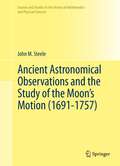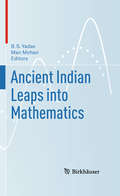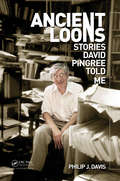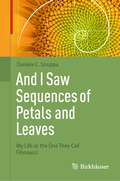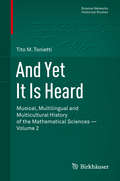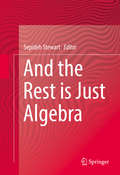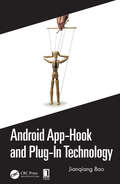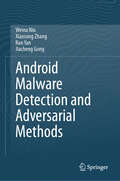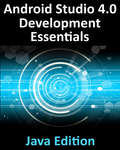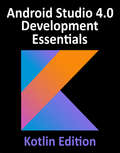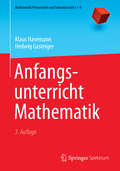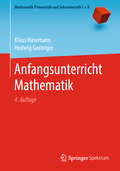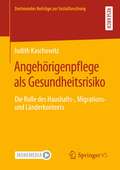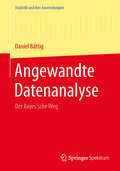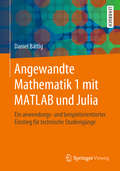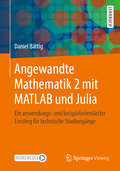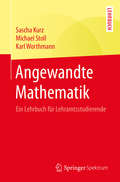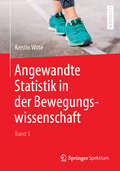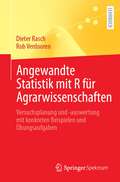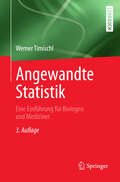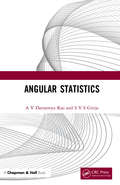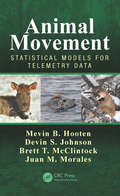- Table View
- List View
Anandadayi Ganit class 2 - NCERT - 23: आनंददायी गणित इयत्ता दुसरी - एनसीईआरटी - २३
by National Council of Educational Research and Trainingइयत्ता दुसरीसाठी असलेले आनंददायी गणित असे नाव असलेले गणिताचे पाठ्यपुस्तक NEP 2020, NCF-FS 2022 तसेच पायाभरणीच्या टप्प्यासाठीचा अभ्यासक्रम यांच्या शिफारसी डोळ्यासमोर ठेवून तयार केले आहे। बालवाटिका 1 ते 3 तसेच पहिली झाल्यावर (3-8 वर्षे वयात) दुसरीत जाणाऱ्या मुलाला अंकांचे ज्ञान झालेले असते, असे यात गृहीत धरले आहे। परंतु, आपल्या देशातील विविधता बघता, कदाचित काही मुलांची एकदम शाळेत पहिलीत गेल्यावरच पहिल्यांदा अंकांची ओळख होत असेल, असेही होऊ शकते। हे क्रमिक पुस्तक तयार करताना अशा परिस्थितीचाही विचार केलेला आहे। वयाच्या या टप्प्यावरील मुले मुक्तपणे खेळणे, खेळणी यात रमतात। हे लक्षात घेऊन, अवकाशीय समज, अंकहाताळणी, गणितीय आणि संगणकीय संकल्पना इ। शिकवण्यासाठीच्या उपक्रमांमध्ये खेळ, खेळणी यांचा वापर करण्यासाठी पुष्कळ वाव ठेवलेला आहे। यामुळे प्रत्येक नवीन संकल्पना किंवा कौशल्य शिकताना मूर्त वस्तूंकडून चित्रस्वरूपाकडे व त्याकडून अमूर्त कल्पनांपर्यंतचे संक्रमण सहजपणे होऊ शकते। सर्वांगीण विकासासाठी अनुभवातून शिक्षण हे उद्दिष्ट डोळ्यासमोर ठेवून, इयत्ता दुसरीसाठी असलेल्या आनंददायी गणित या पुस्तकामध्ये, वर्गात आणि वर्गाबाहेर करण्यासारखे अनेक उपक्रम दिले आहेत। यातील सर्व प्रकरणांमध्ये, उपक्रमाधारित कार्यांच्या माध्यमातून गणितीय संकल्पनांचे आकलन करून दिले आहे। सक्तीने, नाखुषीने गणित शिकण्याऐवजी, आपण खेळ खेळत आहोत अशा भावनेने मुलांनी हे उपक्रम करावेत आणि त्याद्वारे गणितीय संकल्पना आपोआप रुजाव्यात, अशा प्रकारचे वातावरण निर्माण करण्याचा प्रयत्न या पुस्तकातून केलेला आहे।
Anandmay Ganit class 1 - NCERT - 23: आनंदमय गणित १ली कक्षा - एनसीईआरटी - २३
by Rashtriy Shaikshik Anusandhan Aur Prashikshan Parishadआनंदमय गणित कक्षा 1 पाठ्यपुस्तक का निर्माण करते हुए मुख्य रूप से राष्ट्रीय शिक्षा नीति 2020 ने प्रारंभिक विकासात्मक चरण (3 से 8 वर्ष) के दौरान सीखने की एक मज़बूत नींव विकसित करने के महत्व को मान्यता दी है। इसमें बुनियादी साक्षरता और संख्यात्मकता पर ज़ोर देने के साथ-साथ बच्चों का संज्ञानात्मक विकास शामिल है। पाठ्यचर्या के लक्ष्यों, दक्षताओं और सीखने के परिणामों को बुनियादी स्तर की राष्ट्रीय पाठ्यचर्या की रूपरेखा 2022 में स्पष्ट रूप से परिभाषित किया गया है। बच्चों के समग्र विकास के नीतिगत परिप्रेक्ष्य को ध्यान में रखते हुए बुनियादी स्तर के लिए राष्ट्रीय पाठ्यचर्या की रूपरेखा (आधारभूत स्तर) शारीरिक, सामाजिक, भावनात्मक, नैतिक, संज्ञानात्मक, भाषा, साक्षरता, सौंदर्य और सांस्कृतिक और सकारात्मक सीखने की आदतें, जैसे-विकासात्मक डोमेन से जुड़े पाठ्यचर्या लक्ष्यों, दक्षताओं और सीखने के परिणामों की अनुशंसा करती है। इसके अनुवर्ती के रूप में राष्ट्रीय शैक्षिक अनुसंधान और प्रशिक्षण परिषद् द्वारा विकसित आधारभूत स्तर के पाठ्यक्रम में संज्ञानात्मक डोमेन के तहत गणित और संख्यात्मकता सम्मिलित है। पाठ्यपुस्तकों सहित गणित के लिए अधिगम शिक्षण सामग्री विकसित करते समय अन्य सभी डोमेन के एकीकरण पर भी बल दिया गया है।
Ancient Astronomical Observations and the Study of the Moon’s Motion (Sources and Studies in the History of Mathematics and Physical Sciences)
by John M. SteeleThe discovery of a gradual acceleration in the moon's mean motion by Edmond Halley in the last decade of the seventeenth century led to a revival of interest in reports of astronomical observations from antiquity. These observations provided the only means to study the moon's 'secular acceleration', as this newly-discovered acceleration became known. This book contains the first detailed study of the use of ancient and medieval astronomical observations in order to investigate the moon's secular acceleration from its discovery by Halley to the establishment of the magnitude of the acceleration by Richard Dunthorne, Tobias Mayer and Jérôme Lalande in the 1740s and 1750s. Making extensive use of previously unstudied manuscripts, this work shows how different astronomers used the same small body of preserved ancient observations in different ways in their work on the secular acceleration. In addition, this work looks at the wider context of the study of the moon's secular acceleration, including its use in debates of biblical chronology, whether the heavens were made up of æther, and the use of astronomy in determining geographical longitude. It also discusses wider issues of the perceptions and knowledge of ancient and medieval astronomy in the early-modern period. This book will be of interest to historians of astronomy, astronomers and historians of the ancient world.
Ancient Indian Leaps into Mathematics
by B. S. Yadav Man MohanThis book presents contributions of mathematicians covering topics from ancient India, placing them in the broader context of the history of mathematics. Although the translations of some Sanskrit mathematical texts are available in the literature, Indian contributions are rarely presented in major Western historical works. Yet some of the well-known and universally-accepted discoveries from India, including the concept of zero and the decimal representation of numbers, have made lasting contributions to the foundation of modern mathematics. Through a systematic approach, this book examines these ancient mathematical ideas that were spread throughout India, China, the Islamic world, and Western Europe.
Ancient Loons: Stories Pingree Told Me
by Philip J. Davis"Ah, I'm Pingree. We meet again. Splendid. Won't you sit down?"I looked around David's room. Short of the library stacks, I had never seen so many books piled into a single room. Where could I sit down? Every square inch of horizontal surface was covered. Books, papers, notes, manuscripts-all congregated in random and chaotic disorder.This small en
And I Saw Sequences of Petals and Leaves: My Life as the One They Call Fibonacci
by Daniele C. StruppaIn this captivating historical novel, Daniele Struppa skillfully weaves a fictional autobiography, bringing Fibonacci to life with vivid details of his upbringing and adult years in Medieval Europe. As we explore the historical context of Fibonacci's time, we delve into the intriguing aspects of a bygone era, painting a compelling picture of a man whose contributions to mathematics continue to resonate today. From his groundbreaking work on congruent numbers to the famous numerical sequence that bears his name, the author invites readers to imagine the creative sparks that ignited Fibonacci's mathematical innovations. When historical evidence is elusive, accuracy and passion are seamlessly combined, offering plausible scenarios grounded in documented facts. A meticulously crafted apparatus of notes distinguishes fact from fiction, providing readers with a clear guide to navigate this enthralling reconstruction of Fibonacci's life. Step into the medieval world ofLeonardo Fibonacci, one of the most celebrated mathematicians in history, and discover the man behind the mathematical genius. Mathematicians and curious readers alike will appreciate the allure of Fibonacci's mathematical brilliance.
And Yet It Is Heard: Musical, Multilingual and Multicultural History of the Mathematical Sciences - Volume 2 (Science Networks. Historical Studies #47)
by Tito M. ToniettiWe bring into full light some excerpts on musical subjects which were until now scattered throughout the most famous scientific texts. The main scientific and musical cultures outside of Europe are also taken into consideration. The first and most important property to underline in the scientific texts examined here is the language they are written in. This means that our multicultural history of the sciences necessarily also becomes a review of the various dominant languages used in the different historical contexts. In this volume, the history of the development of the sciences is told as it happened in real contexts, not in an alienated ideal world.
And the Rest is Just Algebra
by Sepideh StewartThis book addresses college students' weak foundation in algebra, its causes, and potential solutions to improve their long-term success and understanding in mathematics as a whole. The authors, who are experts in a wide variety of fields, emphasize that these difficulties are more complex than just forgotten rules, and offer strategic approaches from a number of angles that will increase the chances of student understanding. Instructors who are frustrated with their students' lack of skills and knowledge at college level will find this volume helpful, as the authors confront the deeper reasons why students have difficulties with Algebra and reveal how to remedy the issue.
Android App-Hook and Plug-In Technology
by Jianqiang BaoThis book presents the Android plug-in technology used in Android development. This technology is widely used by a majority of Chinese internet companies, and is becoming more widely used worldwide. The book fully describes the history of Android plug-in technology, the installation and startup process, and new features of the Android plug-in technology. It also explores plug-in solutions for peripheral technologies. The book is designed to help Android app developers better understand the underlying technology of the Android system. Features Introduces Android system knowledge, including the communication between AMS and four components Describes the Hook technique by Proxy.newProxyInstance and reflection, to modify Android system behavior, for example, to launch an activity not declared in the AndroidManifest. Shows how to use the Hook apk packaging process in Gradle Covers how to merge the resources in the plugin app and the host app, and how to merge dex of the host app and all the plugin apps Presents the SO technique and how to launch SO files dynamically
Android Malware Detection and Adversarial Methods
by Xiaosong Zhang Weina Niu Ran Yan Jiacheng GongThe rise of Android malware poses a significant threat to users’ information security and privacy. Malicious software can inflict severe harm on users by employing various tactics, including deception, personal information theft, and device control. To address this issue, both academia and industry are continually engaged in research and development efforts focused on detecting and countering Android malware. This book is a comprehensive academic monograph crafted against this backdrop. The publication meticulously explores the background, methods, adversarial approaches, and future trends related to Android malware. It is organized into four parts: the overview of Android malware detection, the general Android malware detection method, the adversarial method for Android malware detection, and the future trends of Android malware detection. Within these sections, the book elucidates associated issues, principles, and highlights notable research. By engaging with this book, readers will gain not only a global perspective on Android malware detection and adversarial methods but also a detailed understanding of the taxonomy and general methods outlined in each part. The publication illustrates both the overarching model and representative academic work, facilitating a profound comprehension of Android malware detection.
Android Studio 4.0 Development Essentials - Java Edition: Build Android apps with Android Studio 4.0 and Java
by Neil SmythExplore Android Studio 4.0 and update your skills to build modern applications in Java Key Features Set up your Android development and testing environments Create user interfaces with Android Studio Editor, XML, and Java Explore the essential elements of Android Jetpack Book Description Android rolls out frequent updates to meet the demands of the dynamic mobile market and to enable its developer community to lead advancements in application development. This book focuses on the updated features of Android Studio (the fully integrated development environment launched by Google) to build reliable Android applications using Java. The book starts by outlining the steps necessary to set up an Android development and testing environment. You'll then learn how to create user interfaces with the help of Android Studio Layout Editor, XML files, and by writing the code in Java. The book introduces you to Android architecture components and advanced topics such as intents, touchscreen handling, gesture recognition, multi-window support integration, and biometric authentication, and lets you explore key features of Android Studio 4.0, including the layout editor, direct reply notifications, and dynamic delivery. You'll also cover Android Jetpack in detail and create a sample app project using the ViewModel component. Finally, you'll upload your app to the Google Play Console and handle the build process with Gradle. By the end of this book, you'll have gained the skills necessary to develop applications using Android Studio 4.0 and Java. What you will learn Design impressive UI for Android application using Android Studio Editor and Java Understand how Android Jetpack can help you reduce the amount of code Explore unique ways to handle single-touch and multi-touch events Trigger local and remote notifications on the device Integrate biometric authentication into an Android app Create, test, and upload an Android app bundle on Google Play Store Who this book is for This book is for application developers and Java programmers who want to explore Android Studio 4.0 to create powerful Android applications. A basic understanding of Java and the Android SDK will be helpful.
Android Studio 4.0 Development Essentials - Kotlin Edition: Build Android Apps with Android Studio 4.0 and Kotlin
by Neil SmythUpgrade your Android Studio skills and confidently create, test, and upload Android applications using KotlinKey FeaturesDiscover how to set up Android development and testing environmentsPractice object-oriented programming (OOP) in KotlinExplore all the major elements of Android JetpackBook DescriptionKotlin as an Android-compatible programming language is becoming increasingly popular. Fully updated for Android Studio 4.0, this book will teach you the skills necessary to develop Android-based applications using Kotlin.Starting with the basics, this book outlines the steps necessary to set up Android development and testing environments, and goes on to introduce you to programming in Kotlin. You'll practice Java to Kotlin code conversion and explore data types, operators, expressions, loops, functions, as well as the basics of OOP in Kotlin. You'll then learn about Android architecture components and advanced topics, such as intents, touchscreen handling, gesture recognition, multi-window support integration, and biometric authentication. As you make progress, you'll explore Android Studio 4.0's key features, including layout editor, direct reply notifications, and dynamic delivery. You'll also delve into Android Jetpack and create a sample app project using ViewModel, the Android Jetpack component. Finally, you will upload your app to Google Play Console and model the build process using Gradle.By the end of this Android book, you'll be fully prepared to develop applications using Android Studio 4.0 and Kotlin.What you will learnBuild Android apps by writing less error-prone code using KotlinReduce the amount of code using Android JetpackExplore unique ways of handling single and multi-touch eventsTrigger local and remote notifications on the deviceIntegrate biometric authentication into an Android appCreate, test, and upload an Android app bundle on Google Play StoreWho this book is forIf you are an application developer or programmer who wants to learn how to build reliable Android applications using Kotlin and Android Studio 4.0, then this book is for you. A basic understanding of programming languages and Android SDK is necessary.
Anfangsunterricht Mathematik (Mathematik Primarstufe und Sekundarstufe I + II)
by Klaus Hasemann Hedwig GasteigerEs gibt zahlreiche wissenschaftliche Studien, die zeigen, wie wichtig frühe mathematische Kenntnisse für den späteren Lernerfolg sind. Der mathematische Anfangsunterricht hat deshalb für die Lernentwicklung der Kinder richtungweisende Bedeutung, wobei die individuellen Kenntnisse und Fähigkeiten der Kinder berücksichtigt werden müssen. Dieses Buch widmet sich deshalb zunächst der Entwicklung des mathematischen Verständnisses von den ersten Lebensjahren bis zum Schuleintritt und geht auf Möglichkeiten mathematischer Förderung im Kindergarten ein. Auf lerntheoretischer Basis werden die Inhalte des Anfangsunterrichts in der Schule - Zahlbegriffserwerb, elementares Rechnen, geometrische Fragestellungen sowie Größen und Sachrechnen - ausführlich beschrieben und in praktischen Beispielen konkretisiert. Auch spezielle Zielgruppen, wie Kinder mit Schwierigkeiten beim Mathematiklernen oder mit besonderen Begabungen werden dabei berücksichtigt. Die 3. Auflage wurde neu strukturiert. Ein besonderer Fokus der Neubearbeitung lag auf dem Mathematiklernen im Übergang vom Kindergarten zur Grundschule. Zudem wurden zahlreiche neue Erkenntnisse aus dem Bereich der Vorkenntnisuntersuchungen, der Arbeit mit lernschwachen Kindern und zum Mathematiklernen allgemein eingearbeitet.
Anfangsunterricht Mathematik (Mathematik Primarstufe und Sekundarstufe I + II)
by Klaus Hasemann Hedwig GasteigerEs gibt zahlreiche wissenschaftliche Studien, die zeigen, wie wichtig frühe mathematische Kenntnisse für den späteren Lernerfolg sind. Der mathematische Anfangsunterricht hat deshalb richtungweisende Bedeutung. Für eine gelingende mathematische Lernentwicklung der Kinder ist es wichtig, die individuellen Kenntnisse und Fähigkeiten der Kinder zu kennen, um daran anknüpfen zu können. Dieses Buch widmet sich deshalb zunächst der Entwicklung des mathematischen Verständnisses in den ersten Lebensjahren bis zum Schuleintritt und geht auf Möglichkeiten mathematischer Förderung in Kindertagesstätten ein. Auf fachdidaktischer und lerntheoretischer Basis werden die Inhalte des Anfangsunterrichts in der Schule – Zahlbegriffserwerb, elementares Rechnen, geometrische Fragestellungen sowie Größen und Sachrechnen – ausführlich beschrieben und in praktischen Beispielen konkretisiert. Schwerpunkte sind dabei die Arbeit mit geeigneten Arbeitsmitteln und mit digitalen Medien. Im Fokus der unterrichtlichen Arbeit stehen Kinder mit verschiedenen Voraussetzungen und Fähigkeiten. Deshalb werden auch spezielle Zielgruppen wie Kinder mit Schwierigkeiten beim Mathematiklernen oder mit besonderen Begabungen berücksichtigt. In dieser 4. Auflage sind neben etlichen Farbabbildungen und kleineren inhaltlichen Änderungen auch Abschnitte zu elektronischen Arbeitsmitteln hinzugekommen. Hier liegt der Fokus auf Potenzial und Einsatzmöglichkeiten von Tablets und interaktiven Whiteboards, wobei auch erste Erfahrungen bei ihrem Einsatz im mathematischen Anfangsunterricht diskutiert werden.
Angehörigenpflege als Gesundheitsrisiko: Die Rolle des Haushalts-, Migrations- und Länderkontexts (Dortmunder Beiträge zur Sozialforschung)
by Judith KaschowitzDie Versorgung pflegebedürftiger Angehöriger ist eine der wichtigsten Aufgaben unserer Zeit. Unklar ist, ob damit Gesundheitsverschlechterungen für informell Pflegende verbunden sind. Diese Arbeit geht unter Zuhilfenahme europäischer Längsschnittdaten (Survey of Health, Ageing and Retirement in Europe und English Longitudinal Study of Ageing) der Frage nach, ob informelle Pflege mit negativen Gesundheitsfolgen verbunden ist. Dabei wird berücksichtigt, dass mögliche Gesundheitsfolgen in Abhängigkeit des Ortes (innerhalb oder außerhalb des eigenen Haushalts) und Landes der Pflegeübernahme sowie der Herkunft der Pflegenden variieren können. Im Ergebnis zeigt sich, dass Pflegekonstellationen mit einer großen (emotionalen/räumlichen) Nähe zwischen Pflegenden und Gepflegten sowie in Ländern mit geringem formellen Pflegeangebot besonders belastend sind. Keine Unterschiede in den Gesundheitsfolgen von informeller Pflege zeigen sich dagegen in Abhängigkeit des Herkunftskontexts, sprich Migrationshintergrundes. Die Ergebnisse machen sozialpolitischen Handlungsbedarf bei der Unterstützung Pflegender deutlich und zeigen auf, dass Wohlfahrtsstaaten Rahmenbedingungen schaffen sollten, gesundheitsschonende Angehörigenpflege zu ermöglichen.Die AutorinJudith Kaschowitz ist als Post-Doktorandin an der TU Dortmund am Lehrstuhl für Sozialstruktur und Soziologie alternder Gesellschaften tätig. Sie forscht empirisch quantitativ und international vergleichend zu Fragestellungen im Bereich der Alterns- und Gesundheitssoziologie.
Angewandte Datenanalyse: Der Bayes'sche Weg (Statistik und ihre Anwendungen)
by Daniel BättigAngewandte Datenanalyse, Bayes´sche Statistik und moderne Simulationsmethoden mit dem Computer helfen, nicht direkt messbare Grössen zu bestimmen und Prognosen zu zukünftigen Werten von unsicheren Grössen zu berechnen. Wie dabei vorgegangen werden kann, von der systematischen Sammlung von Daten, von der Frage wie Unsicherheit mit Wahrscheinlichkeiten quantifiziert werden kann, bis hin zu Regressionsmodellen, spannt das Buch den Bogen. Durch seinen systematischen Aufbau mit zahlreichen Beispielen aus der Praxis und seine in vielen Kursen erprobte Didaktik ist das Buch ideal für Studierende in den angewandten Wissenschaften wie Ingenieur-, Natur- und Wirtschaftswissenschaften geeignet.
Angewandte Mathematik 1 mit MATLAB und Julia: Ein anwendungs- und beispielorientierter Einstieg für technische Studiengänge
by Daniel BättigDieses Lehrbuch vermittelt die Grundlagen der höheren Mathematik für ingenieurwissenschaftliche und andere MINT-Studiengänge. Im Vordergrund stehen dabei Analysis, Differenzialrechnung und lineare Algebra als klassische Themen des ersten Semesters. Diese werden anhand von Beispielen und Anwendungen aus Technik, Physik und Chemie vermittelt. Zudem werden systematisch die Programmiersprachen MATLAB und Julia verwendet, um Modelle zu implementieren und mathematische Probleme zu lösen. Zahlreiche Übungsaufgaben runden jedes Kapitel ab, Lösungen dazu sind online verfügbar. Für Lehrende sind darüber hinaus auch Präsentationsfolien zum Buch über die Verlagsseite abrufbar. Das Buch richtet sich an Studierende, die ein Bachelorstudium in angewandten Wissenschaften an einer Hochschule beginnen. Studierenden an technischen Universitäten kann das Buch dank der vielen Beispiele helfen, einführende Kurse in Analysis und linearer Algebra besser zu verstehen. Verschiedene Kapitel zu Zahlensystemen, Vektoren, Funktionen und zur Differenzialrechnung können auch für Kurse an Gymnasien benutzt werden.
Angewandte Mathematik 2 mit MATLAB und Julia: Ein anwendungs- und beispielorientierter Einstieg für technische Studiengänge
by Daniel BättigProf. Bättig hält seit ca. 15 Jahren die "Vorlesung" zur Mathematik 1+2 für Ingenieure (in Bern vor allem Maschinen- und Elektroingenieure) - die Studierenden lesen das Skript "häppchenweise" eigenständig und können dann in der Lehrveranstaltung Fragen dazu stellen. Das Skript ist daher gut lesbar und mit zahlreichen Anwendungen, Beispielen und Plausibilitätsbegründungen (anstelle von formalen Beweisen) gespickt. Der Autor wird es noch deutlich überarbeiten.
Angewandte Mathematik: Ein Lehrbuch für Lehramtsstudierende
by Sascha Kurz Michael Stoll Karl WorthmannMathematik! Aber wozu soll das bitte gut sein? Fast jede Lehrerin und jeder Lehrer wurde bereits mit dieser Frage konfrontiert. Dieses Buch macht den (Mehr-)Wert von Mathematik erfahrbar, indem Sie Algorithmen kennenlernen, mit denen Sie eine Vielzahl praktisch relevanter Probleme lösen können.Aufbauend auf Grundkenntnissen der Analysis und linearen Algebra unternehmen wir einen Streifzug durch die Angewandte Mathematik:Angefangen mit dem Lösen linearer und nichtlinearer Gleichungssysteme über die lineare Optimierung bis hin zu modernen Verfahren der Computeralgebra. So finden Sie leicht ein passendes Thema, um die Lebenswelt Ihrer Schülerinnen und Schüler aktiv mit mathematischen Methoden zu verknüpfen: Sei es, indem Sie die Bevölkerungsentwicklung basierend auf realen Daten prognostizieren oder wirtschaftliche Prozesse optimieren. Oder auch, indem Sie vermeintlich altbekannte Aufgaben wie die Multiplikation so lange kneten, bis Sie und Ihr Computer sie wirklich schnell und effizient lösen. So bekommen Sie unter anderem neue Impulse für Schwerpunktthemen oder Facharbeiten.
Angewandte Statistik in der Bewegungswissenschaft (Band 3)
by Kerstin WitteDieses Buch soll Studierende als auch Doktoranden motivieren, eigene Studien mit dem richtigen Untersuchungsdesign zu planen und durchzuführen.Für viele bewegungswissenschaftliche Untersuchungen müssen statistische Verfahren angewendet werden. Doch oft fällt es den Studierenden schwer, das jeweils geeignete Verfahren zu finden. Dieser Band soll helfen, insbesondere Studierenden der Sportwissenschaft zu helfen, die statistischen Grundlagen zu verstehen. Dabei unterstützt eine Vielzahl von Übersichten über die Verfahren und Abbildungen ihre Wirkungsweise. Viele sportmotorische Beispiele werden erläutert, um die Anwendbarkeit und den Praxisbezug zu demonstrieren. Zu den vertiefenden Aufgaben gibt es auch einen Abschnitt mit Hinweisen zur Lösung der in Band 2 gestellten empirischen Aufgaben.Auf folgende Themenschwerpunkte wird besonders eingegangen: empirische Forschungsmethoden, deskriptive Statistik, Wahrscheinlichkeitstheorie, Parameterschätzung, Aufstellen und Prüfen von Hypothesen, Verfahren zum Testen von Unterschieds- und Zusammenhangshypothesen, Varianzanalyse, Faktorenanalyse, Testtheorie und Zeitreihenanalyse.
Angewandte Statistik mit R für Agrarwissenschaften: Versuchsplanung und -auswertung mit konkreten Beispielen und Übungsaufgaben
by Dieter Rasch Rob VerdoorenDieses Buch führt in die angewandte Statistik für Agrarwissenschaften ein und unterstützt bei der Forschung in der Pflanzen- und Tierproduktion und im Feldversuchswesen. Es nutzt ausgiebig das frei verfügbare Programmpaket R: Über das gesamte Buch hinweg werden im Rahmen umfangreicher Beispiele passende R-Programmcodes angegeben und erläutert. Die Codes können mit eigenen Daten kombiniert und so zur Planung und Auswertung eigener Versuche verwendet werden. So können etwa Wachstumsfunktionen angepasst, Varianzanalysen berechnet oder optimale Versuchspläne und minimale Stichprobenumfänge gefunden werden und vieles mehr. Eine Installationsbeschreibung für R wird ebenfalls zur Verfügung gestellt. Zahlreiche Übungsaufgaben mit Lösungen ergänzen das Buch, so dass es als Lehr- und Nachschlagewerk nutzbar ist. Besonders hervorzuheben ist, dass auch balancierte unvollständige Blockanlagen (BUB) erläutert werden und erstmalig eine vollständige Liste kleinster (mit möglichst geringer Anzahl von Blocks) BUB für bis zu v = 25 Behandlungen und Blockgrößen ≤ v/2 im Netz zur Verfügung gestellt wird. Für Sortenversuche sind die BUB allerdings oft nicht nutzbar, weil sie zu viele Wiederholungen erfordern. Dafür haben sich „verallgemeinerte Gitter“ oder alpha-Anlagen bewährt, die ebenfalls behandelt werden.
Angewandte Statistik: Eine Einführung für Biologen und Mediziner
by Werner TimischlDie "Angewandte Statistik" ist ein Lehr- und Übungsbuch für Anwenderinnen und Anwender der Statistik, die ein Verständnis für statistische Methoden und eine Sicherheit in der Anwendung dieser Methoden erwerben wollen. Vorausgesetzt wird nur die Kenntnis der für den Universtäts- oder Fachhochschulzugang erforderlichen Schulmathematik. Das Lehrbuch führt zuerst in die Wahrscheinlichkeitsrechnung ein und stellt grundlegende Wahrscheinlichkeitsverteilungen vor. Ausführlich werden die Parameterschätzung und das Testen von Hypothesen behandelt. Mit den gängigen Korrelationsmaßen und ausgewählten Regressionsmodellen wird die statistische Grundbildung abgerundet. Die Kapitel über varianzanalytische Modelle und multivariate Verfahren geben einen Einblick in zwei weitere, für die statistische Praxis relevante Gebiete. Darüber hinaus werden Vertiefungen und spezielle Anwendungen in ergänzenden Abschnitten bereitgestellt. Zahlreiche, vollständig durchgerechnete Beispiele und Übungsaufgaben mit einem ausführlichen Lösungsteil machen die "Angewandte Statistik" zu einem Arbeitsbuch, das sich auch zum Selbststudium eignet. Die Ausrichtung auf die Statistik-Software R (durch Verweise auf die entsprechenden R-Funktionen und die Angabe des R-Codes bei den Lösungen der Aufgaben) trägt der Bedeutung computerunterstützter Problemlösungen in der statistischen Praxis Rechnung.
Angular Statistics
by A V Rao S V GirijaDirectional data arise in the form of circular / semicircular / axial, symmetric / asymmetric, uni / bimodal data, in practical situations of varied fields. For the purpose of modeling such kind of data sets, the data scientists found that existing models as inadequate. As there is paucity of angular models, and to fill the gap, this book is designed at constructing new angular models with the existing techniques and to develop new tools of constructing angular models with an application to control charts in angular models. This book is planned to cover the following topics in nine chapters Wrapped, stereographic and offset circular models Construction of angular models using Rising Sun function, positive definite sequences, discretization and through differential approach Extemporaneous Semicircular / arc and asymmetric l – axial models Choice of angular models as an inferential aspect and construction of control charts for angular data as an application are presented. This graduate level book will be useful for data scientists, researchers and research students of Statistics and allied fields.
Animal Movement: Statistical Models for Telemetry Data
by Juan M. Morales Mevin B. Hooten Devin S. Johnson Brett T. McClintockThe study of animal movement has always been a key element in ecological science, because it is inherently linked to critical processes that scale from individuals to populations and communities to ecosystems. Rapid improvements in biotelemetry data collection and processing technology have given rise to a variety of statistical methods for characterizing animal movement. The book serves as a comprehensive reference for the types of statistical models used to study individual-based animal movement. Animal Movement is an essential reference for wildlife biologists, quantitative ecologists, and statisticians who seek a deeper understanding of modern animal movement models. A wide variety of modeling approaches are reconciled in the book using a consistent notation. Models are organized into groups based on how they treat the underlying spatio-temporal process of movement. Connections among approaches are highlighted to allow the reader to form a broader view of animal movement analysis and its associations with traditional spatial and temporal statistical modeling. After an initial overview examining the role that animal movement plays in ecology, a primer on spatial and temporal statistics provides a solid foundation for the remainder of the book. Each subsequent chapter outlines a fundamental type of statistical model utilized in the contemporary analysis of telemetry data for animal movement inference. Descriptions begin with basic traditional forms and sequentially build up to general classes of models in each category. Important background and technical details for each class of model are provided, including spatial point process models, discrete-time dynamic models, and continuous-time stochastic process models. The book also covers the essential elements for how to accommodate multiple sources of uncertainty, such as location error and latent behavior states. In addition to thorough descriptions of animal movement models, differences and connections are also emphasized to provide a broader perspective of approaches.
Animales a bordo: Animals on Board (Spanish Edition) (MathStart 2)
by Stuart J. Murphy“Kids, young and old, fall in love with math when they see how real-life and effortless it becomes thanks to these books.” —Kimberly D. Mueller, Ed.D., First Grade Teacher, Ashbrook School, Lumberton NJThis high-quality Spanish-language book can be enjoyed by fluent Spanish speakers as well as those learning the language, whether at home or in a classroom.Sáobete al camián de Jill y su perro y suma junto con ellos los animales que ven pasar en el camino. Estos animales son muy especiales y van a un lugar que te sorprendera.The MathStart series has sold over 1.5 million copies and combines math with fun stories that have real-life applications. In Animales a bordo, a Level Two MathStart, simple addition equations help children to understand basic arithmetical operations.Math skills are life skills, and the MathStart series supports success!This award-winning series by Stuart J. Murphy teaches math through stories and visual models63 books divided into three levels with 21 books in eachFun activities kids will love are included to help parents and teachers emphasize the lessonsEngaging and relatable stories, with each story revolving around practical applications of the math concept presentedLively art from top-notch illustratorsCharts and other visual representations help children understand how the math works and promote deeper comprehensionMathStart's unique combination of stories, illustrations, and visual models helps teachers and parents in the teaching of math and provides all children with the opportunity to succeed.The math concepts taught in MathStart books conform to state and national standards. Level 1 is Pre-K–Kindergarten; Level 2 is Grades 1–3; Level 3 is Grades 2–4. The series follows math topics across grades so there is a foundational path to learning that runs through the levels.Help kids with their math skills plus their reading skills with the engaging and fun MathStart series!

